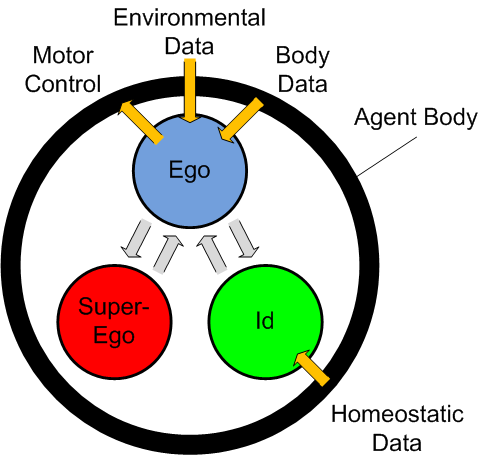Top-down level 1
The technical psychoanalytical model of the human psyche has been developed in tight cooperation with psychoanalytic advisors. Because of its unique (in psychoanalysis) engineering-like properties, Freud’s second topographical model (which is also called structural model in psychoanalysis) builds the core template theory the top-down approach has been applied to. Freud indentifies three main functional units describing the structure of the human psyche: The Id, the Ego and the Super-Ego. To be able to derive a decision-making process of an embodied, autonomous agent the functionalities and interactions between theses three agencies have to be identified.
The psychic representatives of the bodily needs origin from the Id and are formed as drives. The Ego deals with contradictory inputs and has to draw final decisions, influenced by the Id (bodily-related) the Super-Ego (social-related) and reality.
As part of the Id the module, the Input handler covers all the necessary functionality to generate and process drives and perceptions in the form of thing presentations out of sensor values. In the module Affect generator the functionality of generating affects and connecting them to thing presentations is consolidated.
The Ego on the other hand is responsible for psychic mediation between Id, Super-Ego and reality to meet the demands of drives as well as environmental and social rules. The module Primary decision contains the defense mechanisms as well as a collecting pond for the repressed contents coming back from the defense mechanisms. Beside storing and rearranging repressed contents, here the contents get prioritized with respect to other contents that have their origin in actual homeostatic or environmental perception. The Ego includes all deliberative functions that are not part of the preprocessing of the perceived sensations in the Id, described above. This is the main function of the Ego but it requires incoming sensor data and the possibility to alter the environmental conditions by activating the available actuators. Therefore, it is secondly responsible for the bidirectional interaction with the environment that is included in the functional block Secondary decision, which triggers corresponding sensors and actuators.
Albeit the organizational form of primary or secondary process, the Ego, and therefore all perceptual and deliberative processes are directly or indirectly influenced by social rules. The Super-Ego evaluates current situations and is giving positive feedback in the case of kept Super-Ego advises. It can be decomposed into two further functional modules: The Primary advisor and the Secondary advisor, the latter will be used for managing safety critical rules. The purpose of these Super-Ego functionalities can be compared to the “normative behavior” described in [SMFvL06]. It influences the decision making process on the two different processing levels (primary and secondary) to meet the demands of socially and learned behavior necessities as well as application-dependent. It further supports and is a key component for ethical reasoning. With this component, agents become able to estimate the impact of their taken actions on surrounding and affected individuals.
More detailed information: Top-down level 2.
